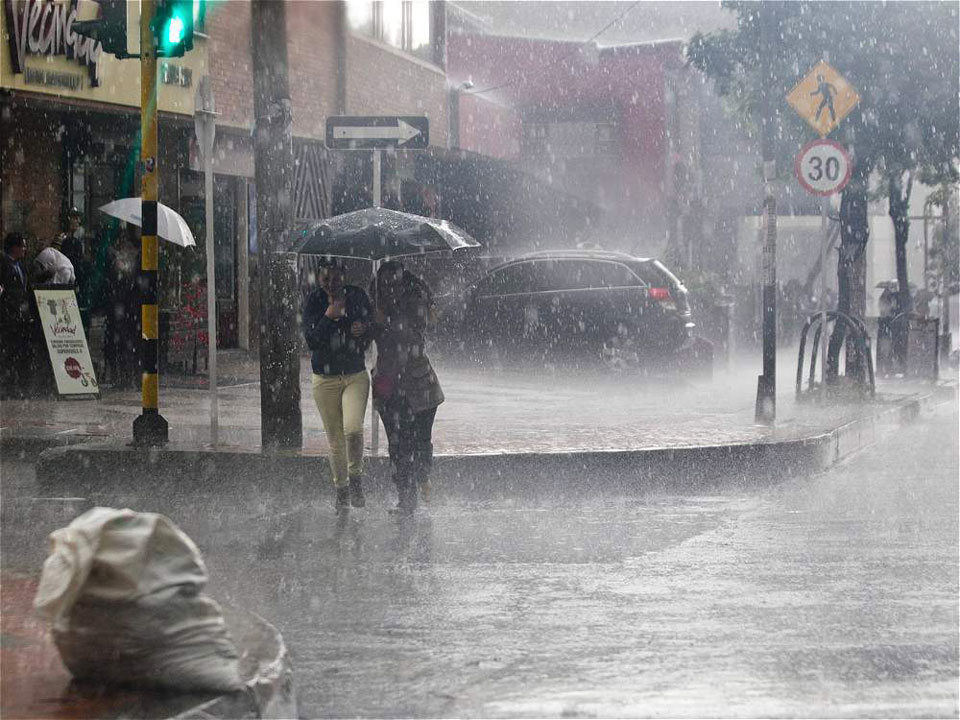
A rainbow covers La Macerena as storm clouds brew in the background.
Rain? Sun? Hail? In his latest column on some of the idiosyncrasies of life here, Gerald Barr says your guess on Bogotá weather is as good as his.
After several years in the city, I am still getting my head around the Bogotá weather. Just when I think I have learned the pattern of drizzle, torrential rain and warm sun – like some never-ending late spring in Scotland – some new meteorological phenomenon throws a spanner in the works, such as El Niño (the boy-child) who brings droughts then floods, or his sister La Niña, who brings floods then droughts – or did I get it the wrong way round? I’m confused. All I know for sure is that I don’t want to meet their dad.
I’m not complaining about the Bogotá weather. Actually, I love the climate; it is often refreshing, invigorating and dramatic. I just want to understand it better. This comes from many years of living in the windswept British Isles, stuck out in the Atlantic where the TV weather forecast is watched more than the news and being properly prepared for the elements is a national obsession. Our house hallways were always decked out like minor lifeboat stations with rubber boots and heavy-duty rain-gear.
In contrast, people in Bogotá have a fairly relaxed attitude towards the climate, rarely preparing themselves fully for rainfall and looking down a little bit on those who do. I realised this when collecting my daughter from school in a downpour in clothes that can only be described as apocalyptic. I was wearing bright yellow industrial rubber boots (for oil rig workers, I think, but the only ones in my size) and a bright yellow cycle cape.
The other parents cowering from the rain in the entrance porch laugh as I wade across the road, now a river, towards their location. “You came well prepared”, someone jibes as I join them on the porch, shedding even more water over their white sneakers and Velez leather shoes. In Bogotá, looking good takes precedent over staying dry.

The dichotomy of the weather in Bogotá, streets of water…
Of course umbrellas are for sale on every street corner, but of such poor quality as to be almost a disposable item, and the rain is so heavy the bounce-back of the street soaks you from the bottom up. Not to mention the road-river-road you are wading in. Many people prefer to use a newspaper or whatever bag or documents they are carrying to shield themselves from rain, or just wait it out in a shop-front.
A friend explains this general lack of rain preparation is a symptom of the fact that a lot of people in Bogotá actually come from somewhere else, often somewhere much hotter such as the Colombian coast. There, a heavy rainstorm is an excuse to run outside semi-naked with a bar of soap given the reality in some cities that water rarely comes out of the tap.
But I suspect it is also because in Bogotá, more than any city I have ever been in, there are many months of the year where the weather gods play endless tricks on the humans below them by sending grey clouds scudding across the horizon like angry battleships then – bingo – out pops the sun. Then of course, comes an unexpected blast of icy rain from behind the mountain on an otherwise sunny day.
This uncertainty is hardly surprising given the geographic location of the city, close to an Andean ridge that divides the sweaty Magdalena valley from the sweltering plains of the Orinoco. Hot air laden with moisture rides up the slopes to engage in what can only be called meteorological hand-to-hand combat with the cooler mountain air; a struggle you can witness from just about anywhere in Bogotá if you look above the green ridges to the east of the city.
Warm fronts push and shove to cross the divide, but are buffered back by winds from the east. Clouds can dump rain or just disappear in the high dry air as quickly as they formed. Like many battles, the drama has no predictable outcome. In the end, many people living here just think, sod it, no point looking like a plonker in a rain cape just in case.

… or blue skies as far as you can see!
It’s not surprising then, that there is no regular weather slot on the evening news broadcasts. Who would want to stand there and put their name to what might happen next? The climate itself does feature regularly as a news item itself, usually presented as a dramatic emergency based on a drought (sequía) or floods caused by the ola de invierno, the winter spell, though with such regularity that after a while I call it the Colombian weather SNAFU (politely translated as ´Situation Normal – All Messed Up´) compounded in Bogotá by poor drainage. Those drains that do exist are blocked by rubbish or turn into maelstroms that tragically swallow small children.
That’s because, when it does rain, it can really rain. On occasions it dumps hail (granizo) with such speed it accumulates then quickly melts, sparking flooding. The whole city was whited-out in 2008, and several barrios were covered in two feet of hail in 2015.
The few times I have been in a Bogotá hailstorm I have been torn between the urge to seek shelter and the fascination of standing on the street to watch the bouncing ice. However, the best advice is to stay indoors; every year people get injured by the odd giant hailstone.
The colonial Spanish settlers were also puzzled by the weather patterns but decided to shoehorn them into their preconceived notions of the European seasons anyway, eschewing in Colombia the normal convention of tropical ‘wet’ and ‘dry’ seasons and instead declaring ‘winter’ and ‘summer’. This was further complicated by putting summer in the northern hemisphere winter (December and January) and winter in…well just about any other time of year when it might or might not rain.
The colonial founders of Santa Fe chose to centre the city on the wettest part of the Bogotá plains, pushed up against the mountainside in an area referred to today as cielo roto, broken sky. An apt name, since it does feel sometimes like heaven has cracked open and some celestial river is pouring in.

A torrential downpour photographed from Monserate, notice the sun shining in the background! Photo: agaporni, Twitter
The result is that many of the capital’s traditional and wealthier suburbs are much wetter, and the sprawling newer barrios to the south and west much drier, a fact the live-in porter at our block of flats constantly reminds us of when he sets off every weekend to stay with his family in Bosa. “I am off to get some sunshine,” he laughs.
Statistically he is correct: according to IDEAM, the weather service, Bosa has less than half the average annual rainfall (590 mm) and twice as much sun as the wettest spots of Bogotá, which are along the Septima and receive up to 1400 mm a year.
Looking at the stats going back over the decades I realise there is a trend for a double peak of heavy rainfall in Bogotá, in April and October, but enough variation from year to year to keep people guessing. The only time you can really expect consistent dry weather is the few weeks after Christmas, maybe running into February if you’re lucky.
Just when I begin to get some clarity on the weather patterns a farmer friend tells me, “the pasture was doing well in the spring”. I do a double take. Spring? When the hell is spring? “Why, after the rain,” he says. Well, any time of the year then.
“So when is autumn?” I ask. “Don’t be silly, we don’t have autumn in Colombia,” he says. At least that’s clear then.
By Gerald Barr





